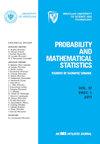i.i.d随机变量部分和最大值序列的强大数定律
IF 0.4
4区 数学
Q4 STATISTICS & PROBABILITY
引用次数: 0
摘要
设0 < p≤2,设{Xn;n≥1}为实值随机变量X的独立副本序列,设Sn = X1 +…+ Xn, n≥- 1。本文从Mikosch 1984的一个定理出发,建立了数列{max1≤k≤n |Sk|;N≥- 1}。更具体地说,给出了limn→∞max1≤k≤n |Sk|log n−1 = e1/p a.s,其中log x = loge max{e, x}, x≥- 0的充要条件。本文章由计算机程序翻译,如有差异,请以英文原文为准。
Strong laws of large numbers for the sequence of the maximum of partial sums of i.i.d. random variables
Let 0 < p ≤ 2, let {Xn; n ≥ 1} be a sequence of independent copies of a real-valued random variable X, and set Sn = X1 + . . . + Xn, n ≥ 1. Motivated by a theorem of Mikosch 1984, this note is devoted to establishing a strong law of large numbers for the sequence {max1≤k≤n |Sk| ; n ≥ 1}. More specifically, necessary and sufficient conditions are given forlimn→∞ max1≤k≤n |Sk|log n−1 = e1/p a.s.,where log x = loge max{e, x}, x ≥ 0.
求助全文
通过发布文献求助,成功后即可免费获取论文全文。
去求助
来源期刊

Probability and Mathematical Statistics-Poland
STATISTICS & PROBABILITY-
CiteScore
0.70
自引率
0.00%
发文量
0
审稿时长
>12 weeks
期刊介绍:
PROBABILITY AND MATHEMATICAL STATISTICS is published by the Kazimierz Urbanik Center for Probability and Mathematical Statistics, and is sponsored jointly by the Faculty of Mathematics and Computer Science of University of Wrocław and the Faculty of Pure and Applied Mathematics of Wrocław University of Science and Technology. The purpose of the journal is to publish original contributions to the theory of probability and mathematical statistics.
 求助内容:
求助内容: 应助结果提醒方式:
应助结果提醒方式:


